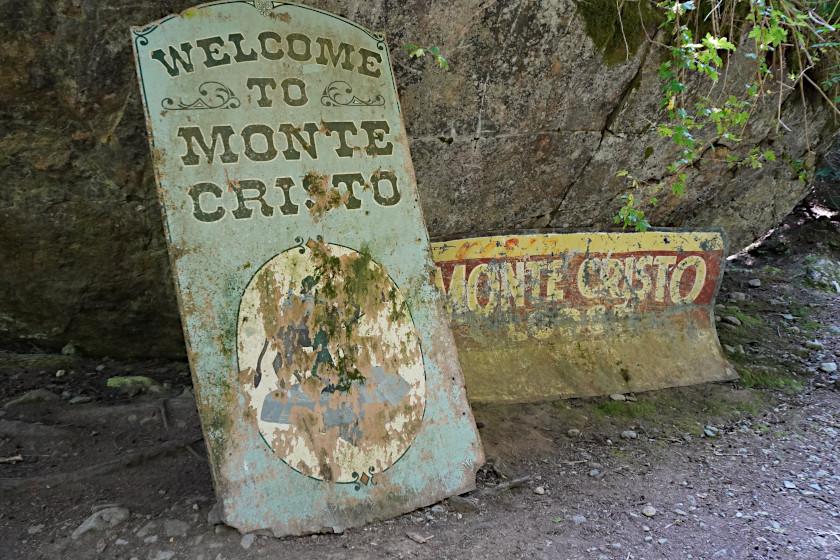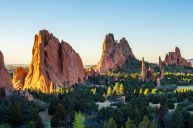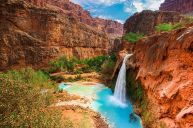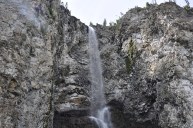After crossing the bridge, we passed a rock with an old metal sign that was worn from years of exposure in the North Cascades. From there, it was a short walk through a stand of pines into a small open meadow. It was here that we finally ran across a few small, old buildings, and the turnstile of the railroad that once brought miners and their families back to this remote area. Gorgeous mountain peaks towered over the old townsite on a beautiful, cloudless day and the old structures immediately ignited the imagination, making one wonder what life in this place was like during the area's mining boom back in 1889.
My friends and I had just completed the hike to Monte Cristo ghost town in Washington State's Snohomish County. As we admired the gorgeous scenery and historic artifacts, we didn't need to say it to one another. This was one of the coolest, and most beautiful day hikes most of us had ever been on. Here's everything you need to know about this hike, and why you'll want to add it to your bucket list of hikes to do in the Pacific Northwest.
A Short History of Monte Cristo

Wikimedia Commons: Kirk
Like many ghost towns of the Pacific Northwest, Monte Cristo was a mining town that saw a rapid rise and fall in the late 1800s. The area sits about 85 miles by highway from present-day Seattle. Back in 1889, the area was explored mainly by prospectors hoping to find a mountain full of riches. According to ghosttowns.com, it was a prospector by the name of Joe Pearsall who first discovered signs of valuable minerals there in 1889.
Word spread quickly, mining claims skyrocketed in the surrounding area, and the town sprang up from there. Roads were built along the South Fork of the Sauk River for better access. By the time 1895 rolled around, there were hundreds of claims, and more than a dozen mines. Two of the major mines were purchased by John D. Rockefeller. At its peak, the town's population reached nearly a thousand residents. From about 1893 until 1896, the town grew steadily and eventually a railway was completed out to the town to help ship the valuable ore back from the five main mines—the Pride, New Discovery, Justice, Golden Cord, and Comet mines. Miners mostly pulled gold, copper, and silver from the surrounding area. Eventually a large ore concentrator was built in 1894. You can still see the collapsed remains of that building to this day.
According to the Washington Trails Association, Monte Cristo was abandoned by 1907. Unfortunately for the miners, the area's riches were only surface deep. Flooding problems within the glacier basin also caused issues. Many workers left the mining camp between 1896 and 1899, many of them drawn further North to the Yukon Territory and the Klondike gold rush. When funding ran out, the Monte Cristo townsite became a ghost town. There was a lodge that remained open to tourists well into the 1980s, but it eventually burned down. Continued flooding closed the only road into town to vehicular traffic and it remains a hiking trail to this day. Today the site is maintained by the Monte Cristo Preservation Association, and they do an excellent job. The trail was clear of debris, and the townsite itself free of human garbage except for the cool historic artifacts left behind.
The Hike

Travis Smola
Most websites put the hike to Monte Cristo at about eight miles round trip. That's mostly true but if you're anything like my group, you'll probably burn more boot leather than that, simply because there are a ton of cool relics to check out at the final townsite. If you're into geocaching, the second oldest geocache in Washington State is hidden near the townsite. Between the geocaches and just general exploring, my group hiked about 11 miles in total. The entire journey took us about six hours to complete from the Barlow Pass trailhead.
The trail itself follows the old Everett and Monte Cristo railroad grade. The tracks are long gone, but you'll still see signs of what the path used to be over a hundred years ago. Most sites put the elevation gain at about 700 feet, but it's a very gradual 700 if that's what it truly is. Most of the path is extremely flat and comfortable for hikers of all skill levels. If you've never done an eight mile hike before, this would be a good one to start out on, as there's nothing too strenuous. As long as you bring a good pair of hiking boots, plenty of water, and maybe a few snacks, you should be fine.
For the most part it's a very safe hike too. There are usually plenty of other hikers out on the trail in case you get into trouble. One thing I will say is that for how full the parking area was, you don't feel any sense of congestion on this trail like you do other popular hiking trails. There is one log crossing over the river about a mile and a half into the hike. It appears the river can get quite treacherous in the spring after all the snow melt and runoff. In mid-August, the water was low, and it made for an easy and safe river crossing.

Travis Smola
Because the town sits in what is now Baker-Snoqualmie National Forest, there is a $5 a day fee for using the trail. My group all rode in one vehicle, and we checked in at the Verlot Public Service Center on Mountain Loop Highway, which sits about 11 miles from the town of Granite Falls. It's a very scenic drive to the trailhead from there. The U.S. Forest Service notes the Darrington Ranger Station as another check-in point.
One thing I feel the need to mention is that at the Monte Cristo trailhead sees a fair share of vehicle break-ins. Most websites don't mention it, and I fear many don't learn about it until they get there and see the warning signs around the parking areas. We recommend keeping everything but the essentials on yourself or back at your hotel or campsite. We suspect most thieves are targeting the vehicles of people using Monte Cristo campground for an overnight stay, but it's worth being cautious for day hikers too. For the record, our vehicle was not broken into during our six-hour adventure.
A Hike Worthy of the Bucket List

Travis Smola
If you love easy hikes that offer breathtaking mountain vistas, tall stands of pine, beautiful wildflowers, and mountain streams, or if you just enjoy history, the hike to Monte Cristo is truly a great one. It's a very popular hike, but it's surprising we don't hear about it more often. Maybe that's just because folks in the Pacific Northwest are a bit spoiled when it comes to scenic places to stretch their legs. Train enthusiasts will love the fact that there's still a rusty old turntable located next to some old structures. Keep following the trail and you can't miss it. If you're still full of energy after your hike, hop on down and give it a push. The center track still rotates! You can see it in action in the vlog I filmed at the location here.
Don't forget to explore some of the spur trails once you finally reach the ghost town. There are quite a few small structures hidden back in the trees that some people miss because they turn around and head back after the main site. All in all, this is our favorite hike we've ever done in Washington, and it's a worthy one to add to your bucket list of trails to visit someday.
For more outdoor content from Travis Smola, be sure to follow him on Twitter and Instagram For original videos, check out his Geocaching and Outdoors with Travis YouTube channels.




